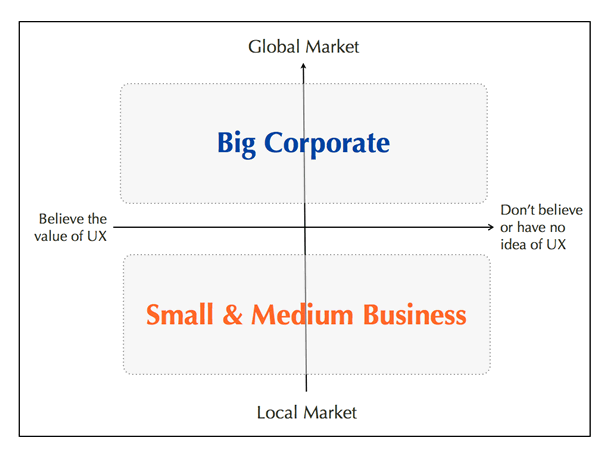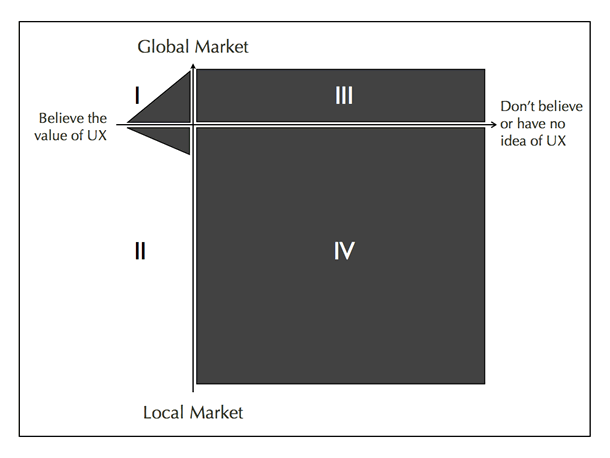User experience is a growing field in Asia. More and more people believe that UX is a key competency to help win markets, earn profits, or build a brand. Companies may still be slow to adopt user experience practices though, because the local business context is unique. Introducing user experience through a global success story is inspiring, but does not always lead the local company to the desired result.
Our UX community in Taiwan, UiGathering, found that regional business conditions do not match those in success stories from other regions, especially stories from the West. To promote user experience effectively in the region, we needed to understand the unique reality in the region, leading us to turn the challenge into a new opportunity, a better approach to advocacy, and a new frontier in UX practice.
To understand regional UX development effectively, we designed a simple matrix to frame the challenge (see Figure 1). This matrix shows the relationship of two factors:
- The target markets that a local business serves, ranging from primarily local to primarily global markets
- The degree of acceptance of user experience in an organization, ranging from little or no knowledge to a full belief in the value of UX

The choice of these factors for analysis reflects the fact that each business context needs its own user experience strategy, and that different levels of acceptance within an organization will also affect the strategy for developing UX-centered design within the organization.
We can see the unique shape of a region by using the matrix as a position map and outlining the number of companies in each quadrant. The matrix identifies the challenge of the unique situation in a region—a starting point for developing an effective strategy to promote user experience. The challenge becomes the basis for a conversation in which we can inspire each other and work towards aligning our efforts in different companies.
In Taiwan’s economy, for example, approximately 96 percent of the business occurs in small and medium-sized companies. Most of them either play a role in the manufacturing supply chain or provide a service in the domestic market. Taiwan also has corporations which serve a global market. These companies tend to be large enough to build a global brand.
Despite the growing local UX community, the importance of the user experience is still not well recognized. Many companies have heard the term, but most of them either have no idea how to incorporate it into business practices or don’t feel it is related to their business at all.
To show the relative size of companies in Taiwan, the horizontal axis has to be pushed up, near the top of the matrix. The relative inexperience with UX is indicated by moving the vertical line to the left as shown in Figure 2.
This analysis is “quick and simple,” but it provides a good overview of a regional UX development, based on insights from companies in Taiwan and casual interviews with other practitioners.

Quadrant I: Large Companies
Believe in the Value of UX
Any company large enough to compete in the global market and to pay attention to user experience usually has a known brand. These companies understand that a product with good user experience is critical and have invested in a UX team to provide the best experience for global customers. Companies like Acer, Asus, HTC, and Trend Micro have incorporated a dedicated UX team in their product development process for many years. To continue their success in the global market, though, they will have to investigate users in different cultures and transform those insights into a meaningful product. The competition to hire talented UX staff creates a great opportunity for people who want to pursue a career in Taiwan.
Quadrant II: Small Companies
Believe in the Value of UX
These companies are retail businesses, service companies, traditional factories, and startups that primarily serve the domestic market. They have gradually come to understand the value of UX through both the mass media and local community events. They are most willing to adopt user experience when they use the Internet and social networking, but they have limited resources. The cost to hire a UX professional, or even outsource a project, could be too expensive for them. The opportunity in this quadrant is to provide an effective solution at an affordable price, so these companies can start to adopt UX practice in a manageable way. This may take designing appropriate methodologies for these small companies.
Quadrant III: Large Companies
Don’t Know UX
In Taiwan, traditional manufacturing companies still play an important role as suppliers in a global market. With increasing competition from countries like China, they are forced to make a choice. Some focus on their current business model and seek to be more competitive; others plan to transform their business into a brand company. For these companies, the acceptance of designing the user experience is still at an early stage. The few UX professionals they hire are often limited to providing only graphic design or styling. Design decision-making is still driven by cost, engineering, schedule, or even the boss’s preference. User-centered culture is not fully developed, and the company culture and mindset have not yet changed. In this situation, it is difficult for any UX process or methodology to have a sustained impact. In-house practitioners struggle to find opportunities for change, while consultants look from outside for effective ways to help companies develop a true UX culture.
Quadrant IV: Small Companies
Don’t Know UX
The last quadrant is the biggest part of this matrix. These companies and government agencies serve the domestic market. They don’t see the relevance of UX to their business at all. Their only motivation or interest comes from being inspired by success stories from other local or regional companies—or demands from the public for change. Without this external support, it is difficult to explain UX in these companies. The challenge in this quadrant is to think of ways we can convince them that every company should think of UX.
For a user experience evangelist, Figure 3 shows the challenge of developing user experience in Taiwan. UiGathering represents a strong local community of UX practitioners who have promoted the importance of the user experience for more than seven years. More than 3,000 people have attended our regular meetings. Our ongoing goal, though, is to move the vertical axis from left to right, enlarging the number of companies who value UX.
To meet that goal the UX community can push, but we also need to consider what forces can help by creating a pull as we move this axis to the right. In the attempt to create this pull, we are planning to do the following in the future:
- Influence government policy. Government has a lot of resources, and funding programs can influence industry’s direction. A good policy for industry could include user experience as a criterion for evaluating program performance. It will definitely force industry to start the practice and embrace the value of good user experience.
- Embed UX within the education system. Even when industry understands the value of UX, companies still need people with the right skills. To supply sufficient human power, the first step is to establish the foundation for a user experience body of knowledge—a common language among practitioners. If we can include UX concepts during education and training, embracing users will become a natural part of the process.
Another way to think about this challenge is the way the matrix is shaped, like a dialog. We should expand the UX dialog to other professions. It is important for us to find a way to connect back to the global UX family, too. User Experience Hong Kong hosted a meeting called “UX in Asia” in 2012. In it, we had the opportunity to share our challenges with the global community and invite others to work with us to solve the regional challenges.

To be effective, we have to shape our user experience advocacy to address the business context in our region. Using this matrix to understand the local and regional challenges can help us create a local story to prove the value of UX in the future. This will not only promote UX in Taiwan, but will foster the growth of UX throughout Asia. Most importantly, it can inspire us to think beyond global and develop each region’s unique strength.用户体验实践的影响与全球商业环境密切相关,但是不同的地区有不同的政治和社会体系,从而形成多样化的商业环境。在讨论用户体验的发展时,将所有地区一概而论是不可能的。本文建议,要确定区域化用户体验的发展挑战,我们要先了解区域化商业环境。文章总结了台湾的用户体验发展概况,提出了一种有效推动用户体验发展的方法。 文章全文为英文版
실제 사용자 경험(UX)의 영향은 글로벌 비즈니스 맥락과 밀접한 관련이 있지만, 지리학적인 지역은 다양한 비즈니스 맥락을 창출하는 자체적인 정치 및 사회 시스템을 갖추고 있다. 사용자 경험 개발을 논의함에 있어, 모든 지역을 일반화시키는 것은 불가능하다. 이 기사는 지역적 UX 개발의 어려움을 파악하기 위해, 우리가 지역적 비즈니스 맥락을 먼저 살펴볼 것을 제안한다. 이 기사는 대만의 UX 개발에 대한 개요를 사용하여 UX를 효과적으로 옹호할 수 있는 방법을 제시한다. The full article is available only in English.
O impacto das práticas de experiência de usuário está fortemente relacionado ao contexto global de negócios, mas as regiões geográficas têm seus próprios sistemas político e social, criando contextos de negócios diversificados. Ao discutir o desenvolvimento da experiência de usuário, é impossível generalizar para todas as regiões. Esse artigo sugere que para identificar o desafio de desenvolvimento da experiência do usuário regional, começamos encarando o contexto regional de negócios. O artigo usa uma visão geral do desenvolvimento da experiência do usuário em Taiwan para sugerir uma forma de defender com eficácia a experiência do usuário. O artigo completo está disponível somente em inglês.
ユーザーエクスペリエンス(UX)を実践する際のインパクトは、グローバルなビジネスの背景に強く関連しているが、地域毎に独自の政治や社会システムが存在することから、様々なビジネス状況が発生している。UXの発展について全ての地域を一般化して論じることは不可能である。この記事では、地域的なUX発展の課題を特定するためには、地域的なビジネスが置かれている状況に目を向けることを提案している。そのために、台湾におけるUX発展の概要を取り上げ、UXを効果的に普及させる方法を提案している。 原文は英語だけになります
El impacto de las prácticas de la experiencia del usuario está estrechamente relacionado con el contexto del comercio global, pero las regiones geográficas tienen sus propias políticas y sistemas sociales, lo cual crea diferentes contextos comerciales. Al hablar del desarrollo de la experiencia del usuario resulta imposible generalizar para todas las regiones. Este artículo sugiere que para identificar el reto del desarrollo de UX regional, comencemos analizando el contexto del comercio regional. El artículo utiliza una descripción general del desarrollo de UX en Taiwán para sugerir una manera de defender con eficacia la UX. La versión completa de este artículo está sólo disponible en inglés.
